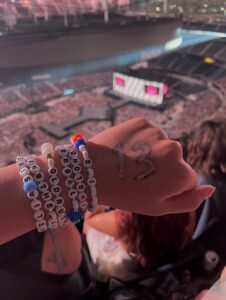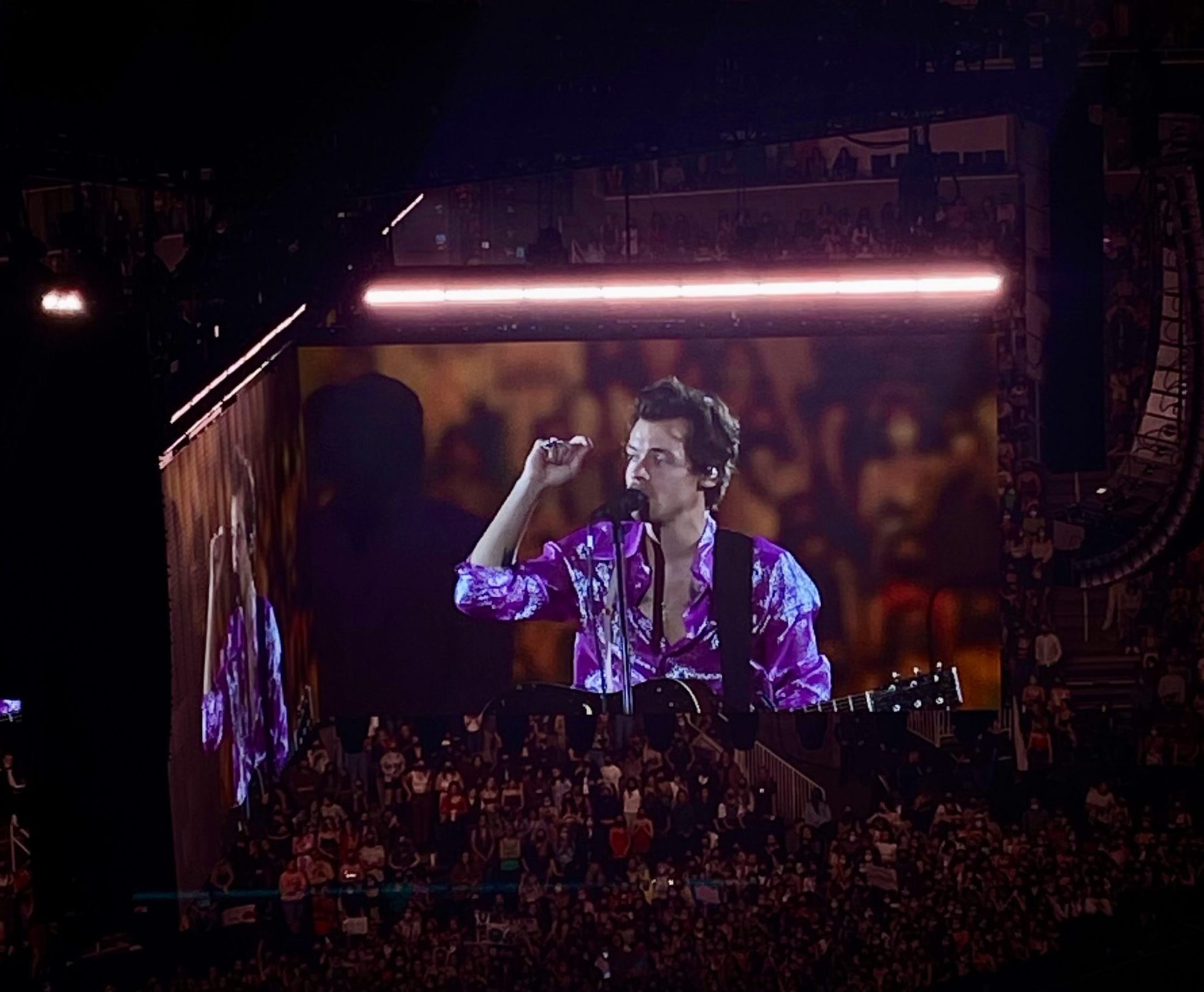This summer, a range of A-list artists were on tour—including Taylor Swift, Harry Styles and Beyoncé—which ignited a stir among thousands of excited Bay Area fans. With each of their shows, the artists have re-defined what it means to go to a concert in their own unique ways. Taylor Swift’s “Eras” tour, Harry Styles’ “Love on Tour” and Beyoncé’s “Renaissance” tour have all given fans a role in the concert experience with the fabulous outfits they wear, loud chants they scream and themed items they bring.
Since its beginning in March, Taylor Swift’s “Eras” tour has captivated the attention of almost 73,000 fans a night. Throughout her three hour set, Swift takes fans on a trip down memory lane — playing anywhere from two to seven songs from each one of her studio albums. As Swift makes her way through the albums, her outfits and set design evolve to reflect the style and feelings associated with that era in her career.
Attendees of the “Eras” tour are eager to take part in Swift’s wardrobe changes — dressing up as their favorite one of Swift’s musical “eras” with intricate outfits and colorful friendship bracelets. Among the thousands of fans in the audience, nearly everyone wears something relating to Swift.

In her song, “You’re On Your Own Kid,” a track from Swift’s most recent album, Midnights, she sings, “So make the friendship bracelets/Take the moment and taste it/You’ve got no reason to be afraid.” Swift released this song just months before the start of the “Eras” tour, and fans immediately attempted to decipher the lyrics. Embedded in the song’s lyrics was a message from Swift. From that point on, “Eras” tour attendees have come to the shows with hundreds of bracelets—in bags, attached to outfits and on wrists.
For many Swifties (Swift’s fandom), trading friendship bracelets builds an unspoken bond between fellow superfans and fosters a strong, safe and welcoming community. Frances Carlson ’26, a Swift fan at Lick-Wilmerding High School, explained the value of trading friendship bracelets at the concert. “Trading the friendship bracelets really broke down the barrier among fans, creating a tight community within the audience which allowed everyone to feel excited and connected, all over our mutual love for Taylor,” she said.
Throughout the concert, you can also hear thousands of Swifties screaming what have been deemed ‘fan chants’ — niche references and lyrics sung loudly during songs. For Swift, this includes singing one-liners during songs like “Bad Blood” and “Delicate.”
For Addison Clem ’26, these chants not only bonded her to other audience members, but to Swift herself. “[The chants] made everyone really excited, especially knowing that everyone had rehearsed them ahead of time. Seeing Taylor’s reactions and facial expressions when everyone would scream a line made me feel like I was right there with her. It made her seem incredibly human,” she said. Moments like these allow fans to not only connect with each other, but also the artist they are supporting.
But fan chants aren’t specific to just Taylor Swift. Fandoms of Harry Styles and Beyoncé have also developed chants during their respective times on tour.
During Harry Styles’s two year long world tour, “Love on Tour,” the Harries (Styles’ fandom) developed many traditions, including fan chants. His most popular fan chant comes from his song “Little Freak,” a track of the album Harry’s House. During this song, in unison, all fan’s scream the line, “You never saw my birthmark.”
“The line speaks to a shared experience between people at the concert and obviously Harry—the experience of feeling like parts of your identity are being overlooked,” said mega-fan Samantha Sherman ’26. “The vulnerability cultivates a deep connection among everyone in the stadium. They’re all simultaneously experiencing the same emotions in their own unique ways. This really builds a community among the fans, creating a safe space for everyone,” she said.
Many fans argue that the most meaningful tradition developed during “Love on Tour” was the wearing of feather boas. During his 2021 Grammy Performance, Styles debuted the feather boa, sending a shock-wave throughout his fandom. This moment allowed for fans to see a different, more self expressive side of Styles that they hadn’t seen before. From then on, fans took it upon themselves to dress in colorful feather boas at his upcoming performances. These feather boas signify Styles’ core values — self expression and fostering a non-judgmental environment. This simple act builds a connection between fans and Styles, and demonstrates the ability to express oneself.
While the Swifties and Harries interpreted the lyrics and behaviors of Swift and Styles, it’s important to keep in mind that not all concert traditions are started by fans.
The Beyhive (Beyonce’s fandom) was given more direct instruction on what to wear during her “Renaissance” tour—her ninth concert tour to date. In an Instagram story, Beyoncé shared that she wanted her fans to be decked out in “fabulous silver” for the shows from August 23 to September 22. Given the late notice, many fans, including Tabitha Paik ’24, knew how dedicated the fan base was and had concerns about the number of fans that would be following Beyoncé’s instruction.
“I didn’t want to be the only person that wasn’t wearing chrome,” they said. The wearing of silver is a tribute to Béyonce—calling attention to her astrology sign (Virgo) and giving fans something to all be dressed in, as a way of showing their dedication and support for her.
The “everyone on mute challenge” is another tradition tailored to the “Renaissance” Tour. During her song “Energy,” Béyonce and her dancers freeze and shush the audience, and everyone goes silent. At the end of the eight-beats, Béyonce is the one to break the silence, resuming her song with incredible enthusiasm. This challenge encourages fans to stay engaged in the concert and is an experience all fans can participate in. The shared excitement in the room helps attendees build relationships with one another, and acts as a point of commonality among them.
With each artist that goes on tour, the traditions evolve, and the bonds between fans become stronger. For many LWHS students, these shared experiences create a community where they are able to build relationships based on the mutual love of an artist and the experiences they’ve had at concerts. For Mathew Yan ’26, “it’s really cool to meet people who are also such big fans of the artists you like, it feels like they immediately know and understand you in so many ways.”




